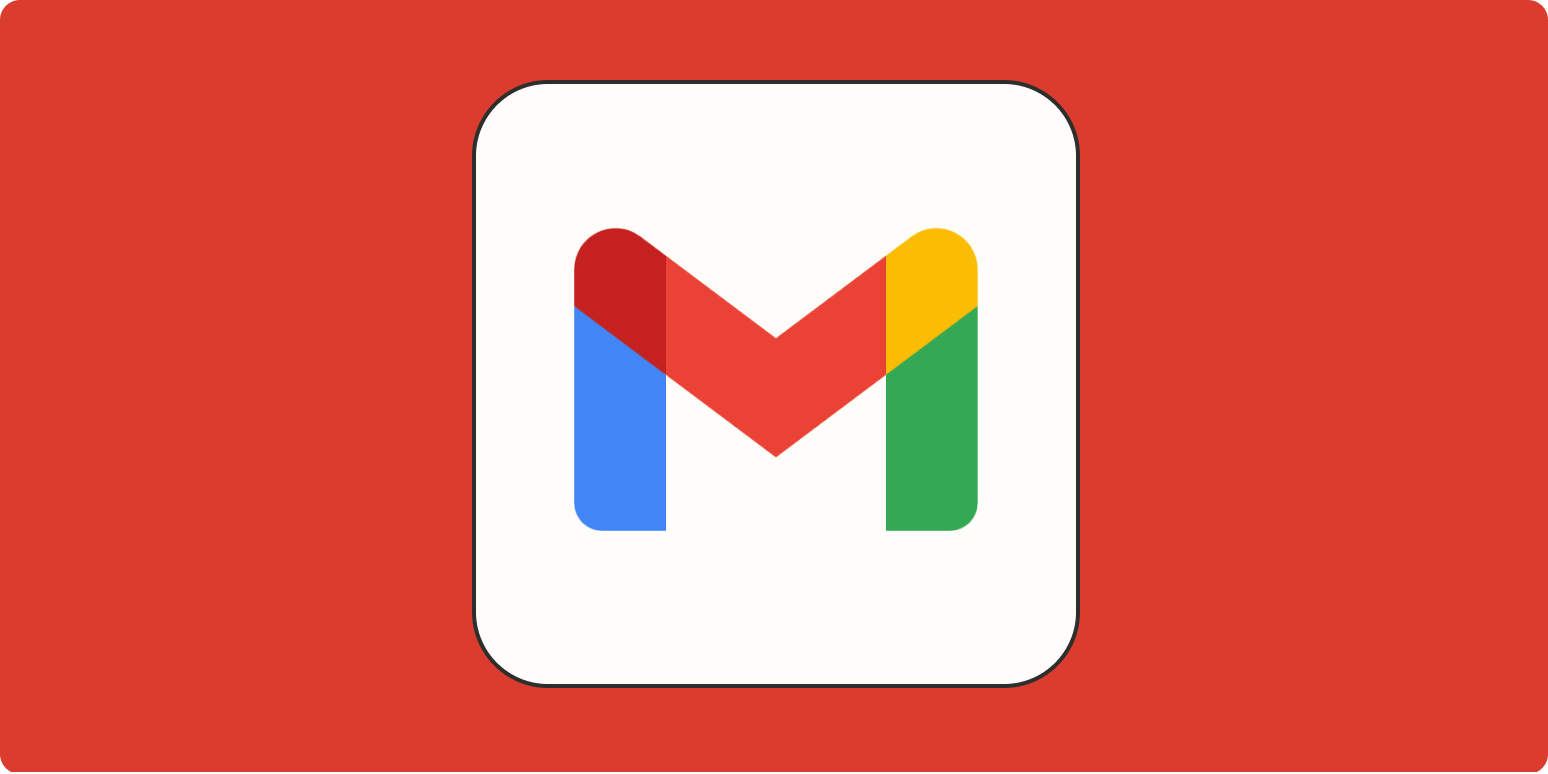When you work in email marketing (which I do), you get a lot of emails. And when you get a lot of emails, you see a wide variety of email sign-offs, signatures, and email disclosures, many of which are…not good.
A personal favorite of mine:
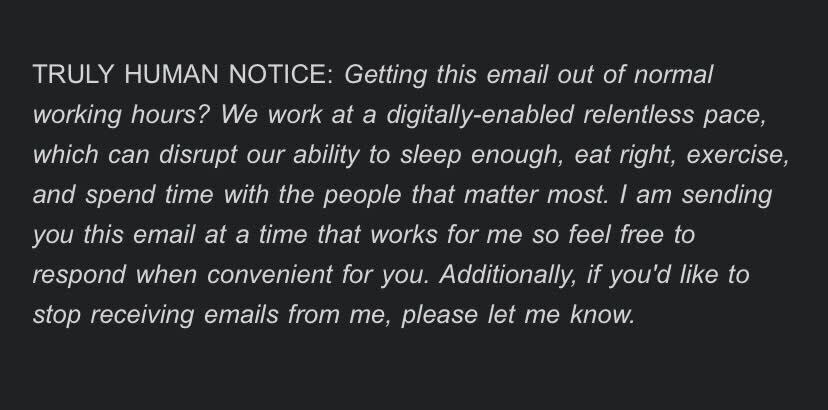
(“I send it when I’m available, you send it when you’re available” is pretty much just how emails work, right? Also: email scheduling is a thing for exactly this reason.)
The conclusion I’ve drawn from my years in the email marketing trenches is that no one should be trusted to create their own email signature. Or, at the very least, using a template is always the safer bet.
To help prevent as many signature faux pas as possible, I asked our designers to create a few free email signature templates to share. They range from polished classic formats to fancier, industry-specific templates with extras like booking links, social media embeds, and product photo carousels.
Once you’ve picked a style you like, you can copy it directly from the email signature templates in this doc. Then, hop down to the bottom of the page for instructions on how to install your email signature.
Free email signature templates for Gmail
The email signatures below live in a Google Doc. Click Get the templates to make a copy of the Google Doc, and then scroll to the bottom of the article for instructions on how to install them.
Simple Gmail signature templates
This first category of signatures contains what you might call “old reliables.” These are simple and straightforward, with a few design extras that lend them a little more polish than a regular, plain-text sign-off. (Personal note: the first one on the list is very similar to the one I use.)
Basic email signature template #1

Basic email signature template #2
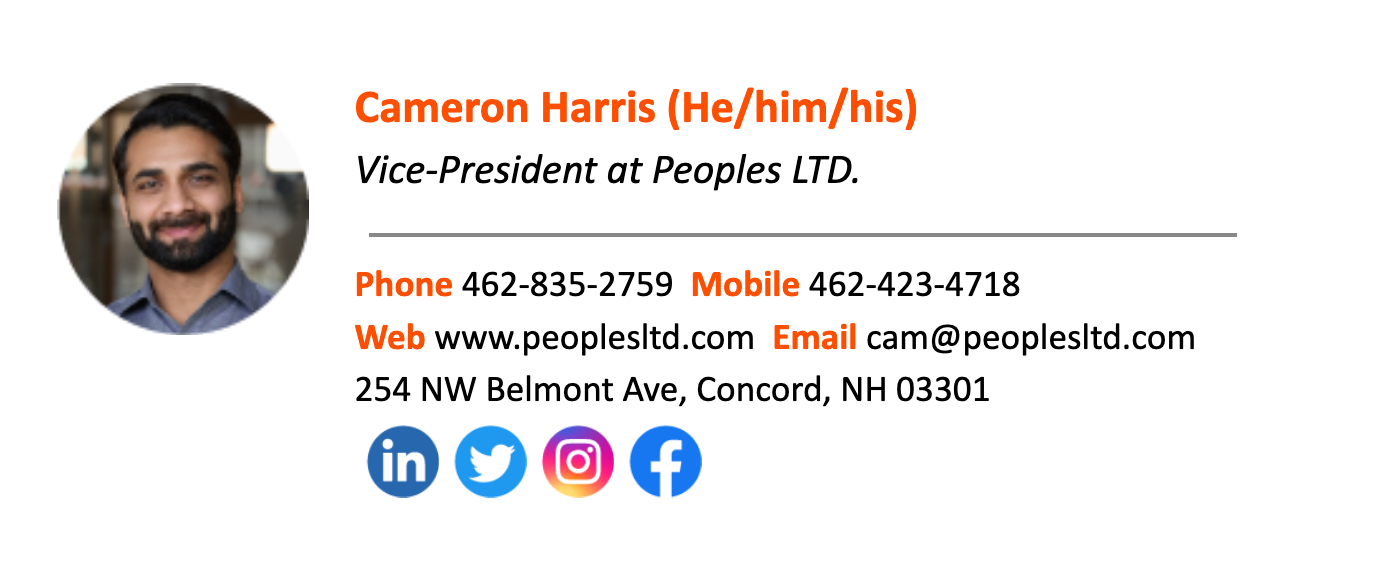
Basic email signature template #3
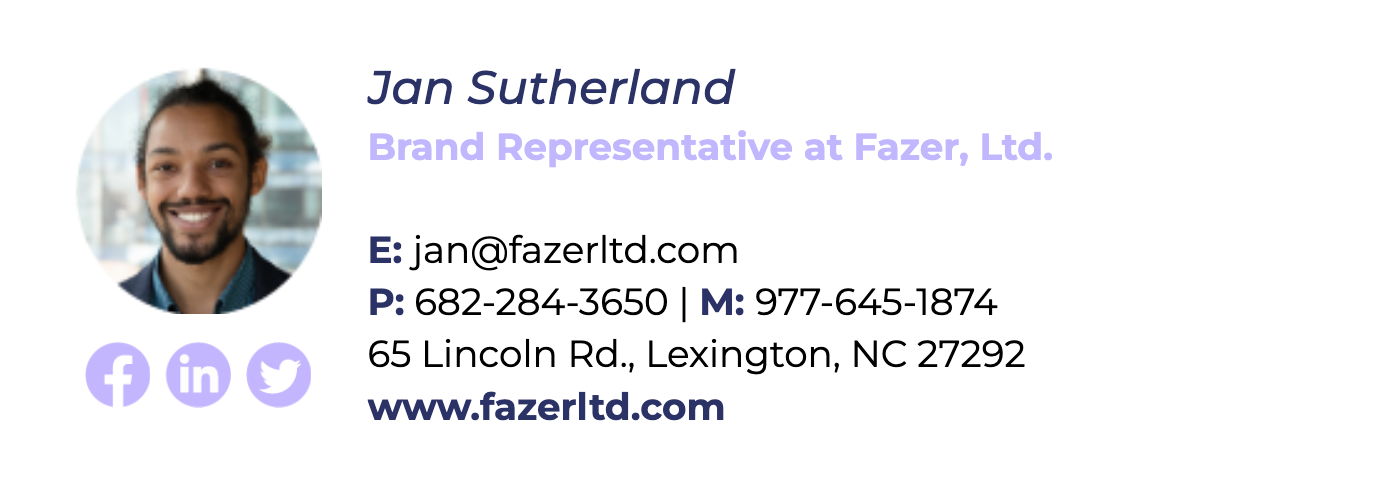
Basic email signature template #4

The circular profile photos in these templates are 75 px in diameter, and the square profile photo is 100 x 100 px.
Professional Gmail signature templates
Short and simple gets the job done, but there are also some pretty cool things you can do with your email signature. These templates offer ways to put your email signature to work for your marketing, advertising, scheduling, and sales efforts.
Brand promoter email signature template
Many companies make a sizable investment in their social media presence. This signature allows you to maximize the return on that investment by getting as many eyes as possible on your content.
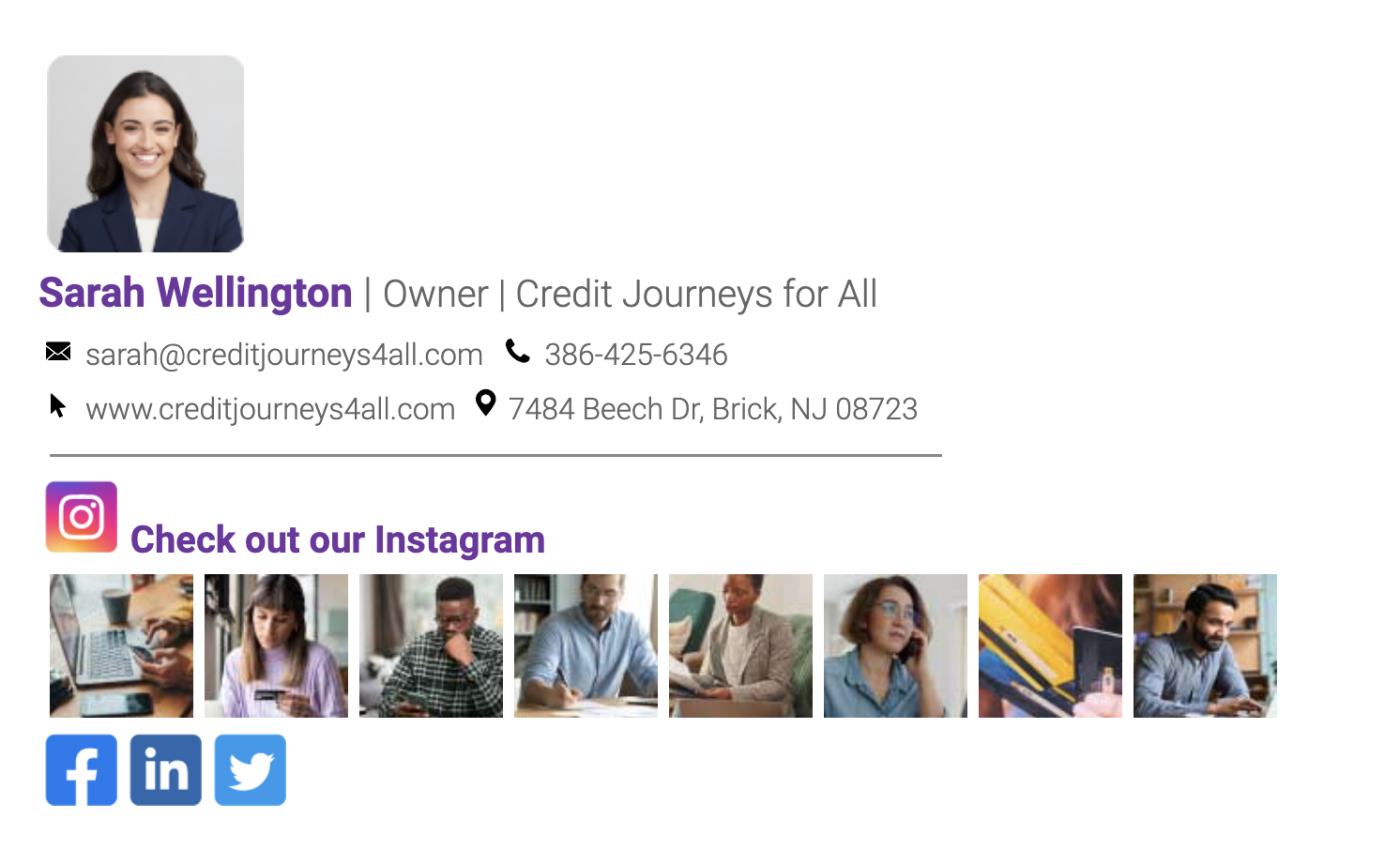
To use this signature, replace the template photos with your own images (sized to 50 px square; profile photo is 75 px square). You can maximize this signature’s impact by using tracking links to collect data on which photos attract the most engagement from your email recipients.
Small business owner email signature template
This signature is designed for independent sellers to showcase their featured products. It’s forward without being pushy, and it allows you to start getting the word out about new products as soon as they drop.

Replace this product photo with an image sized to 80 x 80 px. The profile photo above is sized to 115 px square.
Designer email signature template
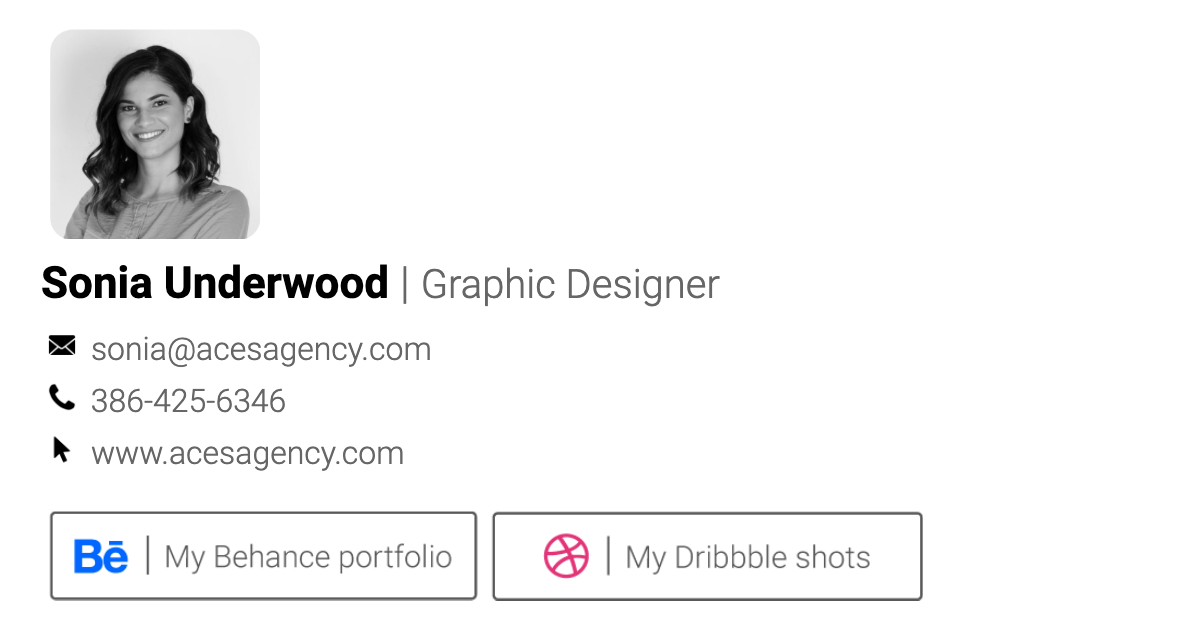
The profile photo above is sized to 75 px square.
Email signature template with appointment scheduler
Nothing garners my brand loyalty as quickly as a super simple booking or purchasing process. Link these signatures to your Calendly or Doodle (or, if you work in the restaurant industry, OpenTable) so that email recipients can make appointments or reservations without picking up a phone.
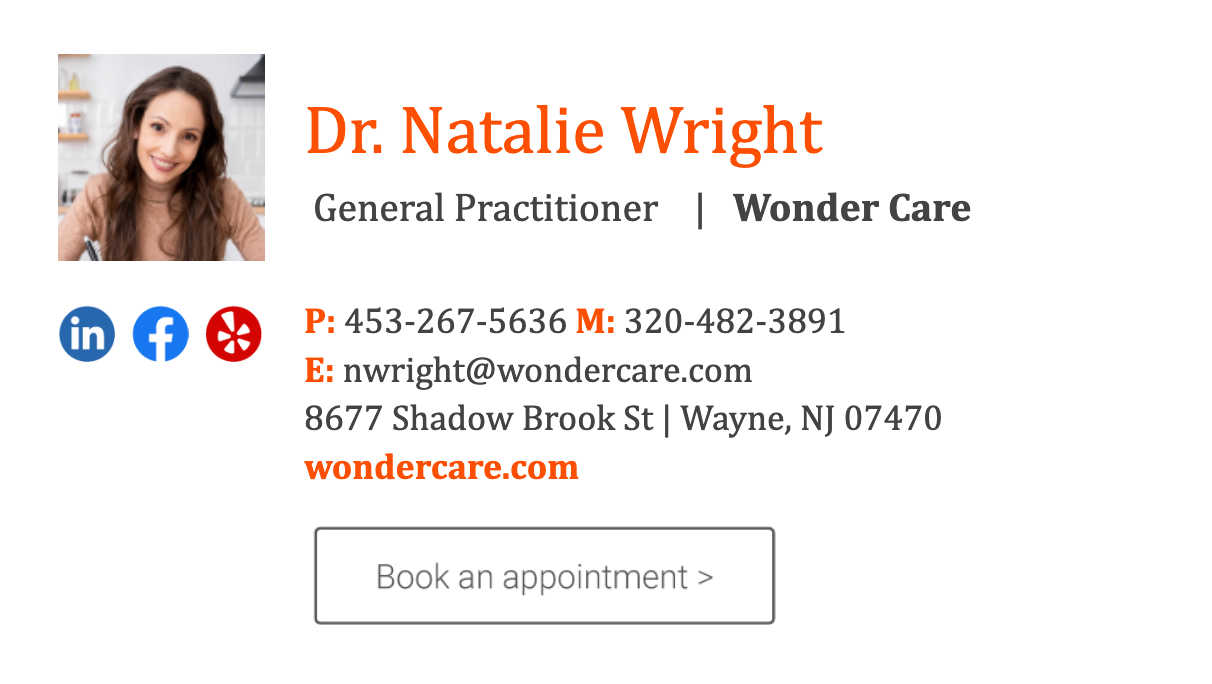
This profile photo is 75 px square.
Restaurant email signature template
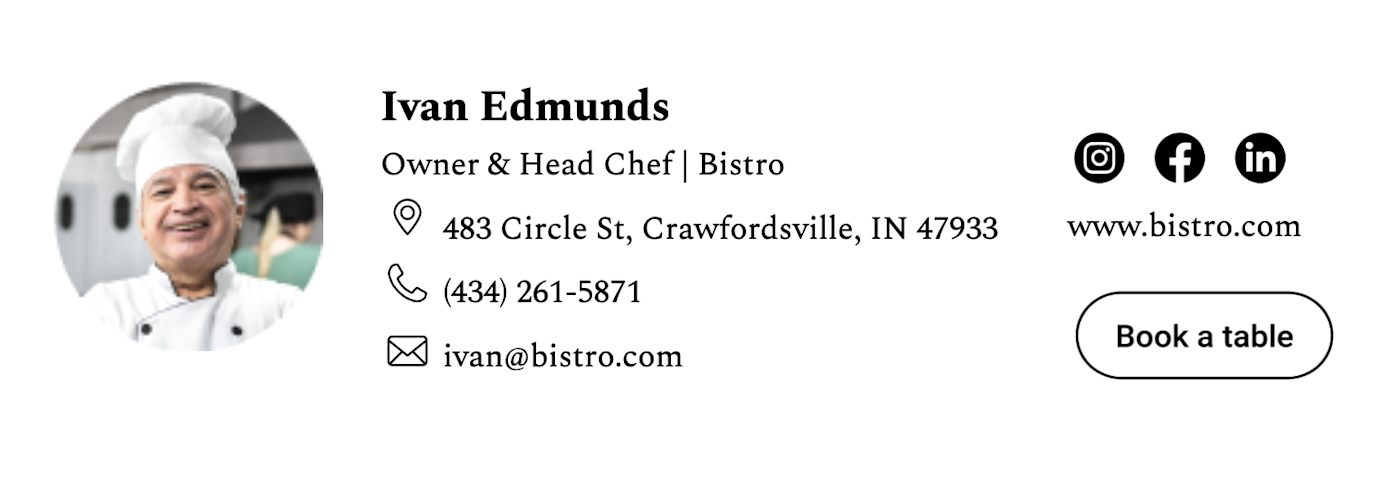
This profile photo is 100 px in diameter.
Sales and retail email signature template
Beautiful website photos are only helpful if people are clicking through to see them. A GIF carousel of your top four or five best-sellers is an eye-catching way to encourage email recipients to click through to see more.
I’ve used this kind of signature in the past, and it gets surprisingly positive feedback. It’s best suited for lifestyle and retail businesses and is less effective in B2B spaces, but don’t shy away from something bold like this.
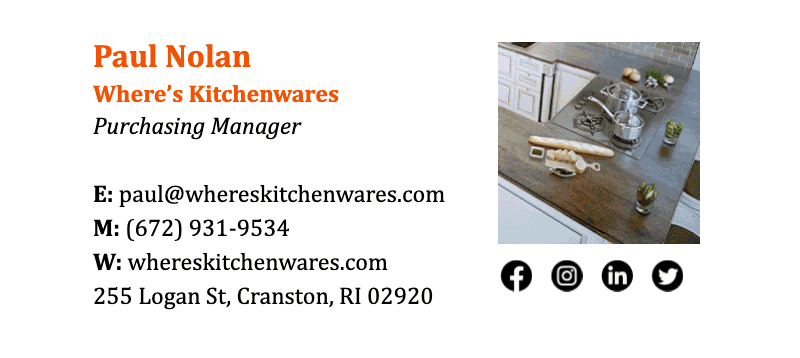
To create a GIF carousel from photos, gather the images you want to showcase and size them to 100 px square. Then use an online tool like GIPHY’s GIF maker to convert them into a slideshow. Add the GIF to the signature the same way you would add a photo.
Sales promoter email signature template
You may not have access to an inflatable tube man to promote your sales, but you can place your sale announcements in your email signature to make sure everyone knows when you’re running a promotion.

Size your sales banner to 450 x 150 px to embed it using the template above. To fit a photo or logo into the space above the banner, use an image that’s sized to 140 x 100 px.
Email signature template for lawyers
In some industries, legal disclaimers are a required part of all professional emails. This signature offers space to include a longer paragraph without sacrificing the email’s clean, professional look.

This profile photo is 105 px square.
Email signature template for realtors
Real estate listings require a little more information than product listings, which can make it difficult to fit a property neatly into your email signature. This template leaves room for two different property photos as well as addresses, prices, number of bedrooms and bathrooms, and total square footage.
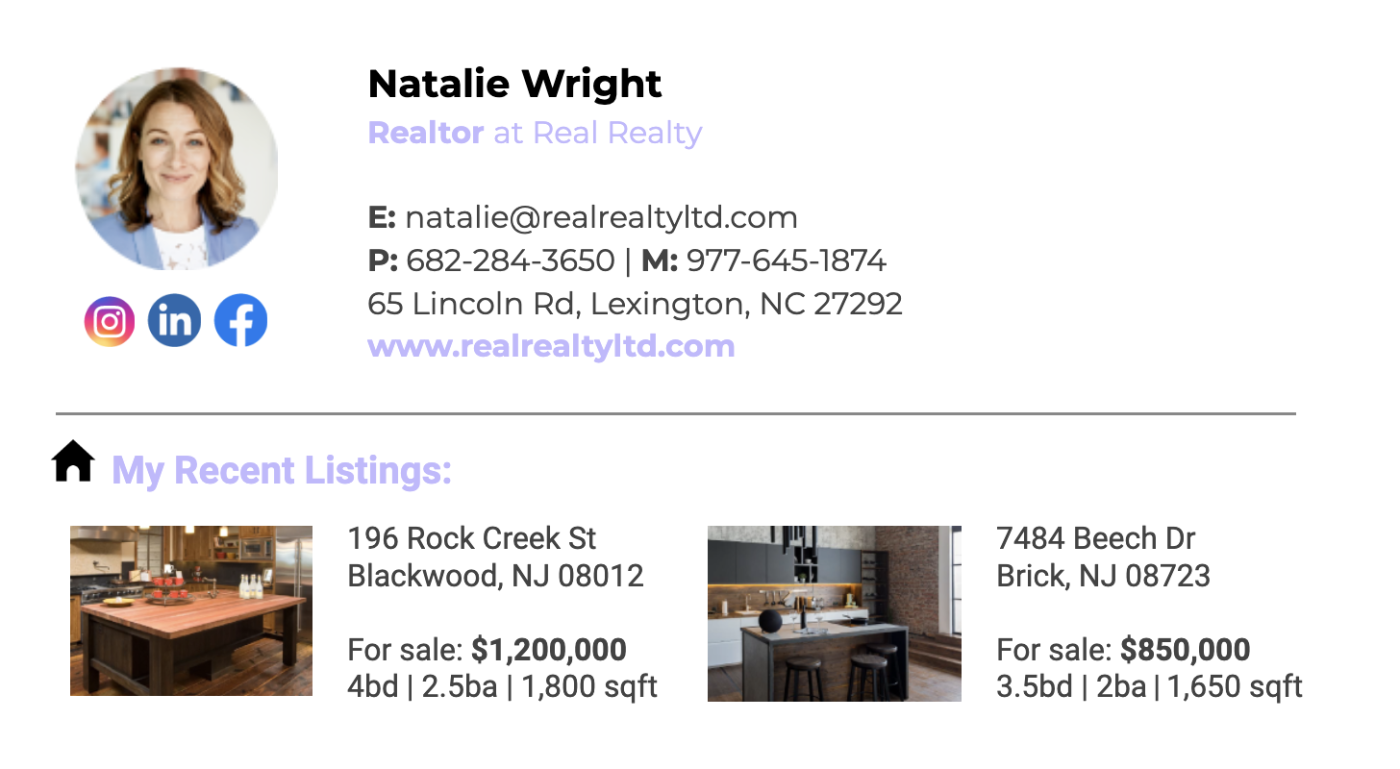
The profile photo in this template is 75 px in diameter. The property photos are 60 x 90 px.
How to install your Gmail signature
Once you’ve selected the template you like, follow these steps to set your Gmail signature.
-
Open your inbox on a desktop. Don’t even attempt to do this on a phone—it’s not worth the headache.
-
Head to the settings gear icon at the top-right corner of the page, then click See all settings in the menu.
-
You’ll automatically land on the General tab. Scroll down until you see the Signature section. The text box to the right of this label is the signature editor.
-
Click Create new. (Gmail now allows you to save multiple signatures, so you can switch between them if you’re emailing for different reasons. If you want to create a second signature, click Save on the one you’re currently creating, and then Create new to start another.)
-
Open the Google Doc with the templates, and copy the template you want to use. Make sure you copy the entire template, even if you don’t want to use certain elements in the signature. This will ensure the signature’s formatting remains intact.
-
Paste the template directly into the signature editor, and then remove the items you’re not interested in.
-
Replace the name, job title, company, and contact information in the template with your own information. (Gmail often automatically adds a hyperlink to web domains and phone numbers—if you don’t want these to be linked or if you don’t want them to appear in traditional hyperlink blue, remove the hyperlink or change the text color manually.)
-
To replace images in the template with your own photos or company logo, place your cursor directly to the right or left of the image you’re replacing and click so that the blinking cursor stays there when you move your mouse. Click the photo icon in the formatting bar, and add an image you’d like to use. (Make sure you’ve sized the image to the dimensions specified for the template you’re using. Gmail does try to offer you the ability to resize photos once they’ve been placed in the editor, but these options are limited, so the only way to guarantee the photo will fit is to size it properly.)
-
Once your image is inserted directly next to the template image in your signature, highlight the template image and delete. Doing it in this order (rather than deleting first and then inserting your photo) will help make sure the photo winds up in the correct place.
-
Add hyperlinks to any social media icons, product listings, portfolio links, and scheduling buttons. There’s nothing more frustrating than a button that’s not connected to anything.
Email signature tips
A neatly-formatted email signature is only half the battle. Before you hit send on any emails with your new sign-off, make sure you’re adhering to the very official rules of email signatures.
Avoid TMI
Lots of these email templates include photos, logos, full physical addresses, and other elements. If you don’t feel like your signature needs all that, that’s completely, 100% ok. Some examples:
-
Profile photos are more popular with people whose careers are client- or customer-facing, since becoming a “familiar face” is an important part of those jobs. But if you don’t feel like having a profile photo in your email signature will benefit you, throw it out.
-
If you work for a fully remote company, you don’t need to put an address there (especially if it would just be your home address).
-
Don’t put your phone number if you don’t want people calling you—it’s that easy. Or you might consider putting a company HQ phone number instead—that way, people have options but not at the expense of your sanity.
We included the maximum amount of information in these templates to make them applicable for a wider range of people, but there’s no “standard” amount of info you should include in your email sign-off.
Do away with the outdated disclaimers
Emails have been being sent from cell phones since 2007. At this point, it’s safe to say that no one cares if your email was sent from your iPhone or not.
The same goes for “sent from mobile, please excuse any typos” disclaimers. Blackberry hasn’t made a phone in over five years, so you can no longer blame your carelessness on your giant-thumb-on-tiny-keyboard syndrome. Phones have spell check; if you choose not to use it or to take a moment to read your message before you send it, the onus for that falls on you, not your technology.
Don’t put your email closing in your signature
It doesn’t take all that much longer to type the word “Best,” or “Thanks!” at the end of an email, and including it as part of your signature makes the sentiment feel less authentic.
If you really feel like including your closing in your signature, at least make sure the closing you choose makes sense. Closings like “Best,” or “Take care,” will be applicable no matter what the content of your email is. But something like “Thanks so much,” or “Talk soon!” is often going to look strange—not all of your emails are going to contain anything worth thanking someone for, and not everyone you email is someone you’re definitely going to speak to again in the near future.
Don’t clutter the thread
In Gmail, there’s a setting just below the signature editor under Signature defaults that allows you to insert your signature before quoted text in replies.

If you value your recipients’ sanity, you should make sure this box is not checked before you save your signature. This setting puts your signature above the content of email threads and forwards, so if you’re corresponding with someone on a longer email thread, it’ll clutter up the entire thread and make it incredibly difficult to read.
Read the room
Even people who might normally appreciate a “cute” email signature probably won’t be receptive to it coming from someone they’ve never spoken to before or don’t know that well. Even if you’re a creative professional, be sure you think about how your recipients will perceive your signature.
A neat, professional signature helps ensure your emails look good for the people reading them, but there are lots of ways to use different extensions and automations to improve your own emailing experience. You can set up automatic emails, import data from email content, and even use automation to organize your inbox, so you have less email stress and more time to focus on other things.
[adsanity_group align=’alignnone’ num_ads=1 num_columns=1 group_ids=’15192′]
Need Any Technology Assistance? Call Pursho @ 0731-6725516

